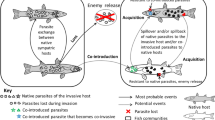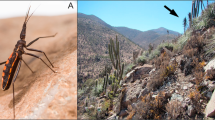Abstract
What determines the abundance of parasites is a central question within epidemiology. Epidemiological models predict that density-dependent transmission has a principal influence on parasite abundance. However, this mechanism is seldom tested in macroparasites, perhaps because multiple, comparable populations of the same host-parasite relationship are rare. We test the influence of a range of factors on parasite abundance across 18 populations of black rhinoceros (Diceros bicornis) in South Africa. Here we show that host density strongly predicts parasite abundance at the population level for both directly and indirectly transmitted parasites. All other models were not supported. The surprising influence of a single key factor, host density, within a complex ecological system demonstrates the validity of simple epidemiological models. Establishing this previously assumed relationship between host density and parasite abundance has major implications for disease control and parasite ecology. For instance, it is central to the idea of population density thresholds for parasitism, below which a parasite would become extinct. Density-dependent transmission is also essential for calculations of the basic reproductive number, and the hypothesis that parasites may regulate host population size.


Similar content being viewed by others
References
Albon SD, Stien A, Irvine RJ, Langvatn R, Ropstad E, Halvorsen O (2002) The role of parasites in the dynamics of a reindeer population. Proc R Soc B Biol Sci 269:1625–1632
Altizer S, Nunn CL, Thrall PH, Gittleman JL, Antonovics J, Cunningham AA, Dobson AP, Ezenwa V, Jones KE, Pedersen AB, Poss M, Pulliam JRC (2003) Social organization and parasite risk in mammals: integrating theory and empirical studies. Annu Rev Ecol Evol Syst 34:517–547
Anderson RM, May RM (1979) Population biology of infectious diseases. Part I. Nature 280:361–367
Anderson MR, May RM (1991) Infectious diseases of humans: dynamics and control. Oxford University Press, New York
Anderson-Lederer RM, Linklater WL, Ritchie PA (2012) Limited mitochondrial DNA variation within South Africa’s black rhino (Diceros bicornis minor) population and implications for management. Afr J Ecol 50:404–413
Arneberg P, Skorping A, Grenfell B, Read AF (1998) Host densities as determinants of abundance in parasite communities. Proc R Soc B Biol Sci 265:1283–1289
Atkinson JAM, Gray DJ, Clements AC, Barnes TS, McManus DP, Yang YR (2013) Environmental changes impacting Echinococcus transmission: research to support predictive surveillance and control. Glob Change Biol 19:677–688
Burnham K, Anderson D (2002) Section 6.6. Random co-efficient models. Model selection and multimodel inference: a practical information-theoretic approach, 2nd edn. Springer, NewYork
Bush AO, Lafferty KD, Lotz JM, Shostak AW (1997) Parasitology meets ecology on its own terms: Margolis et al. revisited. J Parasitol 83:575–583
Cattadori IM, Haydon DT, Hudson PJ (2005) Parasites and climate synchronize red grouse populations. Nature 433:737–741
Denwood MJ, Love S, Innocent GT, Matthews L, McKendrick IJ, Hillary N, Smith A, Reid SWJ (2012) Quantifying the sources of variability in equine faecal egg counts: implications for improving the utility of the method. Vet Parasitol 188:120–126
Diamond J (1986) Overview: laboratory experiments, field experiments, and natural experiments. In: Diamond J, Case T (eds) Community ecology. Harper and Row, New York
Fuentes MV, Sainz-Elipe S, Galán-Puchades MT (2007) Ecological study of the wood mouse helminth community in a burned Mediterranean ecosystem in regeneration five years after a wildfire. Acta Parasitol 52:403–413
Gortázar C, Acevedo P, Ruiz-Fons F, Vicente J (2006) Disease risks and overabundance of game species. Eur J Wildl Res 52:81–87
Haukisalmi V, Henttonen H (1990) The impact of climatic factors and host density on the long-term population dynamics of vole helminths. Oecologia 83:309–315
Hudson PJ, Dobson AP (1995) Macroparasites: observed patterns in naturally fluctuating animal populations. In: Grenfell BT, Dobson AP (eds) Ecology of infectious diseases in natural populations. Cambridge University Press, Cambridge
Hudson PJ, Newborn D, Dobson AP (1992) Regulation and stability of a free-living host-parasite system: Trichostrongylus tenuis in red grouse. I. Monitoring and parasite reduction experiments. J Anim Ecol 61:477–486
IBM (2011) SPSS statistics version 20
Jansen PA, Kristoffersen AB, Viljugrein H, Jimenez D, Aldrin M, Stien A (2012) Sea lice as a density-dependent constraint to salmonid farming. Proc R Soc B Biol Sci 279:2330–2338. doi:10.1098/rspb.2012.0084
Kerr JT, Kharouba HM, Currie DJ (2007) The macroecological contribution to global change solutions. Science 316:1581–1584. doi:10.1126/science.1133267
Kjaer LN, Lungholt MM, Nielsen MK, Olsen SN, Maddox-Hyttel C (2007) Interpretation of serum antibody response to Anoplocephala perfoliata in relation to parasite burden and faecal egg count. Equine Vet J 39:529–533
Lloyd-Smith JO, Cross PC, Briggs CJ, Daugherty M, Getz WM, Latto J, Sanchez MS, Smith AB, Swei A (2005) Should we expect population thresholds for wildlife disease? Trends Ecol Evol 20:511–519
May RM, Anderson RM (1979) Population biology of infectious diseases. II. Nature 280:455–461
Mouritsen KN, Poulin R (2002) Parasitism, climate oscillations and the structure of natural communities. Oikos 97:462–468
Nielsen MK, Vidyashankar AN, Andersen UV, DeLisi K, Pilegaard K, Kaplan RM (2010) Effects of fecal collection and storage factors on strongylid egg counts in horses. Vet Parasitol 167:55–61
Paterson S, Wilson K, Pemberton JM (1998) Major histocompatibility complex variation associated with juvenile survival and parasite resistance in a large unmanaged ungulate population (Ovis aries L.). Proc Natl Acad Sci USA 95:3714–3719
Pedersen AB, Fenton A (2007) Emphasizing the ecology in parasite community ecology. Trends Ecol Evol 22:133–139
Penzhorn BL, Krecek RC, Horak IG, Verster AJM, Walker JB, Boomker JDF, Knapp SE, Quandt SKF (1994) Parasites of African rhinos: a documentation, pp 168–175, tables 1–2. In: Penzhorn BL, et al (eds) Proceedings of a Symposium on Rhinos as Game Ranch Animals, Onderstepoort, Republic of South Africa, 9–10 September 1994, pp i–iv, 1–242
Poulin R (2007) Evolutionary ecology of parasites, 2nd edn. Princeton University Press, Princeton
Stien A, Voutilainen L, Haukisalmi V, Fuglei E, Mørk T, Yoccoz NG, Ims RA, Henttonen H (2010) Intestinal parasites of the Arctic fox in relation to the abundance and distribution of intermediate hosts. Parasitology 137:149–157
Stringer AP (2015) Parasite ecology and the conservation biology of black rhinoceros (Diceros bicornis). Unpublished PhD dissertation, Victoria University of Wellington, Wellington
Stringer AP, Smith D, Kerley GIH, Linklater WL (2014) Reducing sampling error in faecal egg counts from black rhinoceros (Diceros bicornis). Int J Parasitol Parasites Wildl 3:1–5. doi:10.1016/j.ijppaw.2013.10.002
Van Nieuwenhuizen LC, Verster AJM, Horak IG, Krecek RC, Grimbeek JR (1994) The seasonal abundance of oribatid mites (Acari: Cryptostigmata) on an irrigated Kikuyu grass pasture. Exp Appl Acarol 18:73–86
Woodroffe R (1999) Managing disease threats to wild mammals. Anim Conserv 2:185–193
Zajac AM, Conboy GA (2006) Veterinary clinical parasitology, 7th edn. Blackwell, Oxford
Zuur AF, Ieno EN, Walker NJ, Saveliev AA, Smith GM (2009) Mixed effects models and extensions in ecology with R. Springer, Berlin
Acknowledgments
Special thanks go to Eastern Cape Parks and Tourism Agency and associated staff, Dr. Dean Peinke, Ezemvelo KwaZulu-Natal (KZN) Wildlife and associated staff, Chris Kelly, Nelson Mandela Metropolitan University, Prof Graham Kerley, Dr. Shirley Parker-Nance, Victoria University of Wellington, Prof. Graham Le Gros, Dr. Roan Plotz, Dr. Rosalyn Anderson-Lederer, the World Wide Fund for Nature, Dr. Jacques Flamand, Dr. James Martin, Megan Towers, the South African Weather Service, and the owners, staff and black rhino monitors from numerous private reserves for their assistance. This project was made possible by funds from the US Fish and Wildlife Service (grant numbers 98210-6-G102, 98210-4-G920), and a Victoria University of Wellington Doctoral Assistantship.
Author information
Authors and Affiliations
Corresponding author
Additional information
Communicated by Jörg U. Ganzhorn.
Rights and permissions
About this article
Cite this article
Stringer, A.P., Linklater, W.L. Host density drives macroparasite abundance across populations of a critically endangered megaherbivore. Oecologia 179, 201–207 (2015). https://doi.org/10.1007/s00442-015-3319-1
Received:
Accepted:
Published:
Issue Date:
DOI: https://doi.org/10.1007/s00442-015-3319-1




